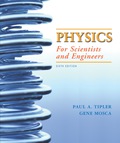
Concept explainers
(a)
To calculate:The wave speed.
(a)
Answer to Problem 103P
The wave speed
Explanation of Solution
Given:
Mass per unit length of the rope =
Tension =
Frequency =
Amplitude =
Formula used:
The wave speed can be calculated as:
Where,
Calculation:
Let, the
From the given data, wave speed can be found out as:
Where,
Now, substituting the all values of the linear density and tension in the equation:
Conclusion:
Thus, the wave speed
(b)
To calculate: The wavelength.
(b)
Answer to Problem 103P
The wavelength
Explanation of Solution
Given:
Mass per unit length of the rope =
Tension =
Frequency =
Amplitude =
Formula used:
The wave speed can be calculated as:
Where,
Sound’s speed:
Frequency of wave:
The wavelength:
Calculation:
To evaluate the wavelength, expression used is:
Where,
Sound’s speed:
Frequency of wave:
The wavelength:
After substituting the values of the
Now, substituting the all values of the linear density and tension in the equation:
Conclusion:
Thus, the wavelength
(c)
To calculate:The maximum transverse linear momentum.
(c)
Answer to Problem 103P
The maximum transverse linear momentum
Explanation of Solution
Given:
Mass per unit length of the rope =
Tension =
Frequency =
Amplitude =
Formula used:
To calculate the maximum transverse linear momentum the expression used is:
Calculation:
Initially, relate the max transverse linear momentum of the
Substitute the numerical values to evaluate
Conclusion:
Thus, the maximum transverse linear momentum
(d)
To calculate: The maximum net force.
(d)
Answer to Problem 103P
The maximum net force
Explanation of Solution
Given:
Mass per unit length of the rope =
Tension =
Frequency =
Amplitude =
Formula used:
To calculate the maximum net forcethe expression used is:
Calculation:
The max net force acting on the segment is the product of the mass of th segment and its max acceleration:
Substitute the numerical values to evaluate
Conclusion:
Thus, the maximum net force
Want to see more full solutions like this?
Chapter 15 Solutions
Physics for Scientists and Engineers
- Can someone help me with this question. Thanks.arrow_forwardIdentical rays of light enter three transparent blocks composed of different materials. Light slows down upon entering the blocks.arrow_forwardFor single-slit diffraction, calculate the first three values of (the total phase difference between rays from each edge of the slit) that produce subsidiary maxima by a) using the phasor model, b) setting dr = 0, where I is given by, I = Io (sin (10) ². 2arrow_forward
 University Physics Volume 1PhysicsISBN:9781938168277Author:William Moebs, Samuel J. Ling, Jeff SannyPublisher:OpenStax - Rice University
University Physics Volume 1PhysicsISBN:9781938168277Author:William Moebs, Samuel J. Ling, Jeff SannyPublisher:OpenStax - Rice University Physics for Scientists and Engineers: Foundations...PhysicsISBN:9781133939146Author:Katz, Debora M.Publisher:Cengage Learning
Physics for Scientists and Engineers: Foundations...PhysicsISBN:9781133939146Author:Katz, Debora M.Publisher:Cengage Learning Glencoe Physics: Principles and Problems, Student...PhysicsISBN:9780078807213Author:Paul W. ZitzewitzPublisher:Glencoe/McGraw-Hill
Glencoe Physics: Principles and Problems, Student...PhysicsISBN:9780078807213Author:Paul W. ZitzewitzPublisher:Glencoe/McGraw-Hill College PhysicsPhysicsISBN:9781938168000Author:Paul Peter Urone, Roger HinrichsPublisher:OpenStax College
College PhysicsPhysicsISBN:9781938168000Author:Paul Peter Urone, Roger HinrichsPublisher:OpenStax College Principles of Physics: A Calculus-Based TextPhysicsISBN:9781133104261Author:Raymond A. Serway, John W. JewettPublisher:Cengage Learning
Principles of Physics: A Calculus-Based TextPhysicsISBN:9781133104261Author:Raymond A. Serway, John W. JewettPublisher:Cengage Learning College PhysicsPhysicsISBN:9781305952300Author:Raymond A. Serway, Chris VuillePublisher:Cengage Learning
College PhysicsPhysicsISBN:9781305952300Author:Raymond A. Serway, Chris VuillePublisher:Cengage Learning





